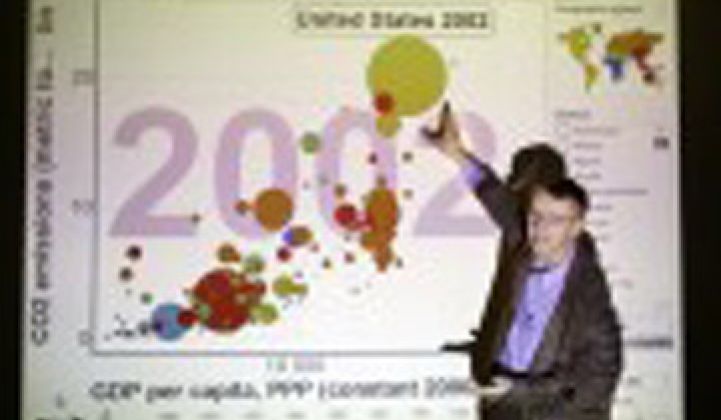What is the world’s most important invention -- the technological breakthrough that has fundamentally changed family life for the better nearly everywhere it has appeared?
The car? The computer? The cell phone?
It’s the washing machine, argues Hans Rosling, a professor at the Karolinska Institutet, who specializes in demographic trends and technology. He says, in fact, that it’s the most time-saving technology in the world today.
When families can afford washing machines, mothers can spend more time working outside the home, attending school, or raising children instead of relentlessly heating water, pounding clothes, and hanging them to dry. Household health improves and over time you begin to see the hallmarks of what we associate with “First World” living standards: longer life spans, fewer children, higher levels of income and a diversified economy.
Rosling speaks from experience. In November 1952, his family in Sweden got their first washing machine, freeing his mother to take the four-year old Rosling to the library more often.
“This technology is what made me a professor,” he said.
If you want to predict the future, study demographics
Populations move in inexorable, yet visible patterns: today’s kids will invariably become tomorrow’s adults.
Rosling takes the long view, studying population patterns over centuries and decades. In 1960, families in Vietnam had an average of seven children and life expectancy hovered around 40 years. In the U.S., families had two kids and life expectancy came to 65 years.
Now, families in both countries have 2.03 kids on average and Vietnam trails the U.S. in life expectancy only by a few years, 70 to 77.
What’s more, average income in Vietnam comes to only $1,700, well below U.S. average at $40,000 a year, but income has soared significantly since the 1960s when it came to $697 per person.
In the 1950s, the childhood mortality rate in Tunisia and other “rising” emerging nations came to around 20 percent. Now, child mortality is down worldwide and 85 percent of the world now lives in countries with families that have fewer than three children on average, a switch from just a few decades ago. Bangladesh has the same birthrate at the U.S. Chalk it up to better medicine, soap, running water and job opportunities.
“The total amount of children in the world, two billion, is not growing any longer,” Rosling said.
Demographics, naturally, are central to the debates over energy and resources. The one billion individuals living in the modern industrial areas like Europe, North America, Japan and Australia consume about as much energy as the remaining six billion people in the rest of the world.
Those six billion, however, will rapidly catch up as their economies grow. Average incomes in rural China came to $500 in 1970. Now, the per capita income exceeds $3,310.
“Forty percent of the U.S. population can find a counterpart in China that has the same income in terms of purchasing power,” Rosling said. The living standard between China and the U.S. could roughly become equivalent by mid-century.
“The trailer was Japan. The feature film is China and the sequel is India,” he added.
A vested interest in energy efficiency
History shows efficiency works on a large scale. The U.S. emits 16 to 18 tons of CO2 per person per year. Sweden, an industrial economy at the same level of development, emits just five tons.
As economies grow at a rapid rate, so do social attitudes. Think back just a few decades. In the 1930s, smokestacks were symbols of industrial activity and might. By 1970, with air pollution choking cities like Los Angeles and Tokyo regulations were imposed that have actually lead to cleaner air and water in Europe, the U.S. and parts of Asia.
China’s rise has been built on heavy industry, but air quality is now a concern. Just breathing the air in Beijing is the equivalent of smoking 52 cigarettes a day, according to Steve Westly, the former controller for the state of California and now a prominent venture capitalist. China, suddenly, has become one of the largest market for solar and wind.
Times and places may change, but people stay the same.



